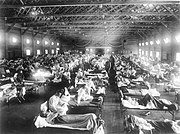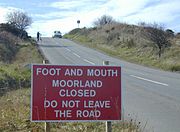Portal:Viruses/Selected outbreak
The following articles are currently featured as the Selected outbreak at the Viruses Portal. To suggest an article for inclusion, use the suggestions page
Portal:Viruses/Selected outbreak/1

The 1918–20 influenza pandemic, the first of the two involving H1N1 influenza virus, was unusually deadly. It infected 500 million people across the entire globe, with a death toll of 50–100 million (3–5% of the world's population), making it one of the deadliest natural disasters of human history. It has also been implicated in the outbreak of encephalitis lethargica in the 1920s. Despite the nickname "Spanish flu", the pandemic's geographic origin is unknown.
Most influenza outbreaks disproportionately kill young, elderly or already weakened patients; in contrast this predominantly killed healthy young adults. Contemporary medical reports suggest that malnourishment, overcrowded medical facilities and poor hygiene promoted fatal bacterial pneumonia. Some research suggests that the virus might have killed through a cytokine storm, an overreaction of the body's immune system. This would mean the strong immune reactions of young adults resulted in a more severe disease than the weaker immune systems of children and older adults.
Portal:Viruses/Selected outbreak/2
The 2009 flu pandemic was an influenza pandemic first recognised in Mexico City in March 2009 and declared over in August 2010. It involved a novel strain of H1N1 influenza virus with genes from five different viruses, which resulted when a previous triple reassortment of avian, swine and human influenza viruses further combined with a Eurasian swine influenza virus, leading to the term "swine flu" being used for the pandemic. It was the second pandemic to involve an H1N1 strain, the first being the 1918 "Spanish flu" pandemic.
The global infection rate was estimated as 11–21%. This pandemic strain was less lethal than previous ones, killing about 0.01–0.03% of those infected, compared with 2–3% for Spanish flu. Most experts agree that at least 284,500 people died, mainly in Africa and Southeast Asia – comparable with the normal seasonal influenza fatalities of 290,000–650,000 – leading to claims that the World Health Organization had exaggerated the danger.
Portal:Viruses/Selected outbreak/3
The West African Ebola epidemic was the most widespread outbreak of the disease to date. Beginning in Meliandou in southern Guinea in December 2013, it spread to adjacent Liberia and Sierra Leone, affecting the cities of Conakry and Monrovia, with minor outbreaks in Mali and Nigeria. Cases reached a peak in October 2014 and the epidemic was under control by late 2015, although occasional cases continued to occur into April 2016. Ring vaccination with the then-experimental vaccine rVSV-ZEBOV was trialled in Guinea.
More than 28,000 suspected cases were reported with more than 11,000 deaths; the case fatality rate was around 40% overall and around 58% in hospitalised patients. Early in the epidemic nearly 10% of the dead were healthcare workers. The outbreak left about 17,000 survivors, many of whom reported long-lasting post-recovery symptoms. Extreme poverty, dysfunctional healthcare systems, distrust of government after years of armed conflict, local burial customs of washing the body, the unprecedented spread of Ebola to densely populated cities, and the delay in response of several months all contributed to the failure to control the epidemic.
Portal:Viruses/Selected outbreak/4
The 1993 hantavirus outbreak in the Four Corners region of southwest USA was of a novel hantavirus, subsequently named Sin Nombre virus. It caused the previously unrecognised hantavirus pulmonary syndrome – the first time that a hantavirus had been associated with respiratory symptoms. Mild flu-like symptoms were followed by the sudden onset of pulmonary oedema, which was fatal in half of those affected. A total of 24 cases were reported in April–May 1993, with many of those affected being from the Navajo Nation territory. Hantavirus infection of humans generally occurs by inhaling aerosolised urine and faeces of rodents, in this case the deer mouse (Peromyscus; pictured).
Previously documented hantavirus disease had been confined to Asia and Europe, and these were the first human cases to be recognised in the USA. Subsequent investigation revealed undiagnosed cases dating back to 1959, and Navajo people recalled similar outbreaks in 1918, 1933 and 1934.
Portal:Viruses/Selected outbreak/5
The last recorded smallpox death occurred during the 1978 smallpox outbreak in Birmingham, UK. The outbreak resulted from accidental exposure to the Abid strain of Variola major, from a laboratory, headed by Henry Bedson, at the University of Birmingham Medical School – also associated with an outbreak in 1966. Bedson was investigating strains of smallpox known as whitepox, considered a potential threat to the smallpox eradication campaign, then in its final stages.
A medical photographer who worked on the floor above the laboratory showed smallpox symptoms in August and died the following month; one of her contacts was also infected but survived. The government inquiry into the outbreak concluded that she had been infected in late July, possibly via ducting, although the precise route of transmission was subsequently challenged. The inquiry criticised the university's safety procedures. Bedson committed suicide while under quarantine. Radical changes in UK research practices for handling dangerous pathogens followed, and all known stocks of smallpox virus were concentrated in two laboratories.
Portal:Viruses/Selected outbreak/6
The 2001 foot-and-mouth outbreak included 2,000 cases of the disease in cattle and sheep across the UK. The source was a Northumberland farm where pigs had been fed infected meat that had not been adequately sterilised. The initial cases were reported in February. The disease was concentrated in western and northern England, southern Scotland and Wales, with Cumbria being the worst-affected area. A small outbreak occurred in the Netherlands, and there were a few cases elsewhere in Europe.
The UK outbreak was controlled by the beginning of October. Control measures included stopping livestock movement and slaughtering over 6 million cows and sheep. Public access to farmland and moorland was also restricted (pictured), greatly reducing tourism in affected areas, particularly in the Lake District. Vaccination was used in the Netherlands, but not in the UK due to concerns that vaccinated livestock could not be exported. The outbreak cost an estimated £8 billion in the UK.
Portal:Viruses/Selected outbreak/7
In the severe acute respiratory syndrome (SARS) outbreak, the first cases of the newly emerged SARS coronavirus were reported in November 2002 from the Chinese Guangdong province. The virus soon spread across Asia, with China, Hong Kong, Taiwan and Singapore being the worst affected countries; a secondary outbreak occurred in Canada. The rapid initial spread of the outbreak has been in part attributed to China's slow response to the early cases. Over 8,000 people were infected, with a case fatality rate of 11%. Those over 65 years had a much higher mortality rate, greater than 55%. The outbreak was contained by July 2003, and no cases have been reported since 2004.
At the time of the outbreak, the immediate source of SARS coronavirus was thought to have been the masked palm civet (Paguma larvata; pictured), which was sold as food in Guangdong markets. The virus was also found in raccoon dogs, ferret badgers and domestic cats. More recent research has suggested that the natural reservoir could be horseshoe bats.
Portal:Viruses/Selected outbreak/8
The 1976 Zaire Ebola virus outbreak was one of the first two recorded outbreaks of the disease. The causative agent was identified as a novel virus, named for the region's Ebola River. The first identified case, in August, worked in the school in Yambuku, a small rural village in Mongala District, north Zaire. He had been treated for suspected malaria at the Yambuku Mission Hospital, which is now thought to have spread the virus by giving vitamin injections with inadequately sterilised needles, particularly to women attending prenatal clinics. Unsafe burial practices also spread the virus.
The outbreak was contained by quarantining local villages, sterilising medical equipment and providing protective clothing to medical personnel, and was over by early November. A total of 318 cases was recorded, of whom 280 died, an 88% case fatality rate. An earlier outbreak in June–November in Nzara, Sudan, was initially thought to be linked, but was shown to have been caused by a different species of Ebola virus.
Portal:Viruses/Selected outbreak/9
Portal:Viruses/Selected outbreak/9
Portal:Viruses/Selected outbreak/10
Portal:Viruses/Selected outbreak/10






